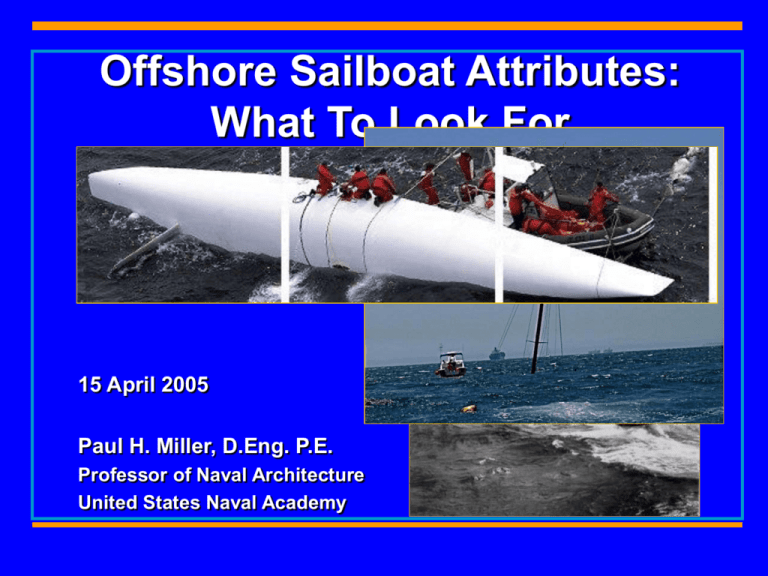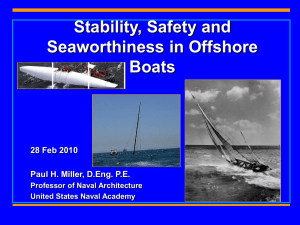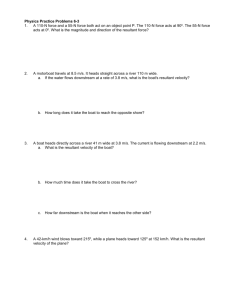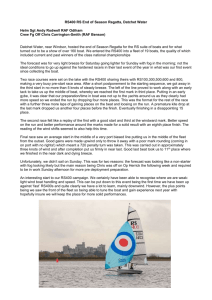Seaworthiness and Safety - United States Naval Academy
advertisement

Offshore Sailboat Attributes: What To Look For 15 April 2005 Paul H. Miller, D.Eng. P.E. Professor of Naval Architecture United States Naval Academy Seaworthiness “To be seaworthy, the vessel must be able to defend itself against the incursion and perils of the sea…” From “Seaworthiness: The Forgotten Factor” by C.A. Marchaj A classic example of a seaworthy design. Low center of gravity, versatile rig, narrow beam. But perhaps a bit impractical? 2 Question: What percentage of recreational marine accidents are related to design, construction or equipment? 1998 USCG Boating Statistics 11% Design, Construction and Equipment Issues 3 Human Error is the biggest problem! 1998 USCG Boating Statistics 89% Owner and Operator Mistakes (Training, Attitude, Preparation, Weather, Fatigue, etc) 4 “To finish first, first you have to finish.” The keel is still there, but the mast is not! 5 How Much Risk Will You Take? “How Lucky Do You Feel?!” Is this your acceptable level? Risk Or, is this? Preparation + Training + Cost + Attitude + Routing 6 For your level of acceptable risk… If your level of training and experience is minimal, then: •Get more training/practice (go to sailing camp!) •Adopt a more conservative attitude to routing •Increase your boat preparation/equipment •Choose a more conservative boat design! Some great voyages have been made in spite of the boat design and equipment! 7 Design Attributes: The Basic Rules to Reduce Risk (Sail or Power) 1. 2. 3. 4. Watertight integrity: Keep Water Out! Stability: Keep the Vessel Upright! Maintain Steering and Weatherliness Simplicity These requirements often conflict with other goals, such as speed vs. comfort vs. cost vs. draft vs. … 8 Watertight Integrity (In Brief) 6. Rudder shaft 1. Hatches/boards 2. Port lights (storm 7. Control lines shutters) 8. Prop shaft 3. Vents/Dorades 9. Locker covers 4. Through hulls 10. Charlie Nobles 5. Mast 11. Construction (ABS Rules) Hint: Give your boat a good shower! Watertight is good, airtight is not! 9 Lessons Learned and Relearned 1. The 1979 Fastnet 3. Boats became more pointed out the stable at large heel dangers of wide angles. beam and light 4. Today, many displacement. “cruising boats” 2. The Rating Rules have wider beams, were changed to lighter encourage displacements and stability. (’98 higher CG’s than Sydney-Hobart) pre-1979 boats… 10 Static (not moving) Stability • • Buoyancy Force acts upward through the center of underwater volume (Center of Buoyancy) Weight Force acts downward through the Center of Gravity B W Sum of the Forces equals Zero! 11 Static Stability When Heeled This lever, the horizontal distance between the Center of Gravity and the Center Buoyancy is called the Righting Arm (RA)! “Give me a lever and I will move the earth!” (or at B least right a boat!) W Righting Moment = Righting Arm x Boat Weight = “Stability” 12 Static Stability When Really Heeled! W W B Limit of Positive Stability “LPS” is when the two vectors are colinear. Moral of this story: A Low Center of Gravity is Nice! 13 Static Stability - Beam Effects “Ballast Stability” “Form Stability” B B W W W Righting Arms! Equal Righting Arms! 14 Static Stability Lessons 1. Beam Provides Stability at Small Angles (<40o) 2. A Low Center of Gravity Always Provides 3. Stability For the Same Initial Stability a Narrow Boat Needs a Lower CG (More Keel Ballast-More Weight?). Positive Righting Moment - Boat Will Return Upright RM Limit of Positive Stability 0 Heel Angle 90 Negative RM Boat Will Capsize 125 180 15 Righting Moment Curves Positive area under the curve = work to capsize! Narrow Boat - Ballast Stability Beamy Boat Form Stability RM 0 Heel Angle 90 125 180 Beamy Boat With Water Sloshing Inside! Negative area under the curve = work to re-right! 16 Dynamic (Moving) Stability A Vessel’s Response to Wind and Waves is a function of: • Sails Set • Static Stability (RA x Boat Weight) • Roll Mass Moment of Inertia • Surface Area Above and Below the Surface • Roll Damping • Luck! Uh Oh! 17 Dynamic Stability “Ballast Stability” vessels tend to follow gravity! (They remain more upright!) “Form Stability” vessels tend to follow the water surface! If the water surface is angled, the boat will be too! 18 Best Approach to Evaluating Capsize Resistance • A large area under the Positive Righting Moment Curve (and small negative area!) • • • • High Limit of Positive Stability Large Displacement Low Center of Gravity Possibly available from the designer 19 Less Rigorous But Easier Evaluators 1. LPS >125 for cruisers (may be available from US Sailing for a sistership, or ask a yacht designer) 2. Ballast/Disp>40% and no shoal keels! 3. Capsize Screening Formula (a rough guide of form vs. ballast stability) Beam What 2 1 happened 3 BoatWeight (lbs ) to CG and 64 length? 20 Screening Factor Examples Hunter 28 LOA = 28’ BEAM = 10.5’ DISP = 7400 LB CSF = 2.15 Tartan 28 Hallberg Rassy 29 LOA = 28’3” BEAM = 9.8’ DISP = 7450 LB CSF = 2.0 LOA = 29’3” BEAM = 9.33’ DISP = 8360 LB CSF = 1.8 21 More Screening Factor Examples Cape Dory 28 Rozinante LOA = 28’2” BEAM = 8.9’ DISP = 9000 LB CSF = 1.7 LOA = 28’ BEAM = 6.25’ DISP = 7100 LB CSF = 1.3 ! Remember that the CSF equation does not include some important terms! (CG, damping, MMI, etc.) 22 Is Bigger Always Better? 1. 2. The Static Stability Curve, Damping and Mass Moment of Inertia terms do not have “length” factors. Center of Gravity, weight, draft, surface area, and beam are more important than length! Bottom Line An increase in length leads to greater comfort, possibly higher stability, higher loads and lower maneuverability. 23 Is “Fast” Unsafe? Can a performance boat be safe? Things to consider: 1. Outrun 2. 3. 4. weather Crew weight! (wide beam) Your Approach Weatherliness (upwind ability) Note the insufficient rudder area! So the answer is “maybe”! 24 Rudder and Keel Area Can You Climb Off a Lee Shore? 1. Stability and appendage area are related At lower speeds you need more area Rough guide: 2. 3. • • Keel Area > 3.5% of Sail Area Rudder Area > 1.5% of Sail Area 25 Three Quotes To Remember “A Modern Sailboat… 1. cannot be too stable.” 2. can be either too weak or too strong.” 3. can have rudders and keels that are too small and are too shoal.” 26 Some “Lower Risk” Offshore Designs (for a couple) Flicka 20 CSF=1.8 Great for newlyweds! Frances 26 CSF=1.7 Enough for 2? Pearson 30 CSF=1.9 Value Cruiser? 27 More “Lower Risk” Offshore Designs (for a couple) Crealock 34 CSF=1.7 Enough for 2? Alerion Express 38 CSF=1.9 My dream boat? Cal 40 CSF=1.8 A great allround design 28 A boat, although a good design, is only as seaworthy as the condition it is in and the skill of the crew that sails it! 29 Attributes that increase risk 1. Shoal draft keels 4. Small keels and (too high a CG, rudders (lack of reduced control at low weatherliness) speed) 2. High windage 5. Racing rigs rigging (steps, 6. Flat bottoms main furlers) 3. Boats that rely on 7. Large windows crew weight for stability 30 “Learn from the mistakes of others, because you won’t live long enough to make them all yourself” 31 “Principles of Yacht Design” “Seaworthiness: The Forgotten Factor” Larsson and Eliasson C. A. Marchaj 32 From US SAILING: Equipment Guides Safety Recommendations for Offshore Sailing or Safety Recommendations for Cruising Sailboats And, “Safety From Capsizing; Final Report” 33 “The Seaworthy Offshore Sailboat” “Desirable and Undesirable Characteristics of Offshore Yachts” John Vigor by the CCA 34 American Bureau of Shipping Guide for Building and Classing Offshore Racing Yachts The Elements of Boat Strength by Dave Gerr 35 One final thought: Buy the smallest boat you can afford… And go have fun! 36







